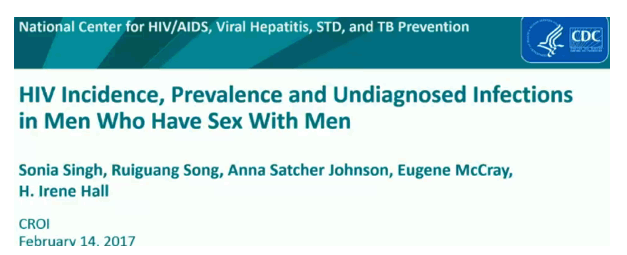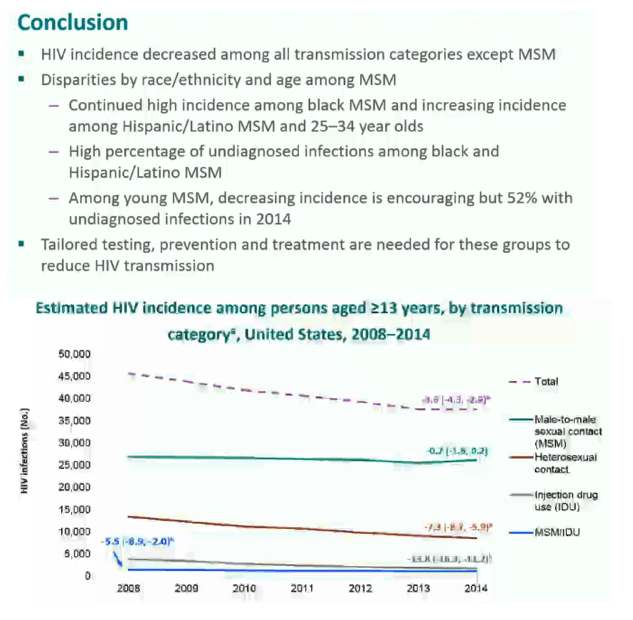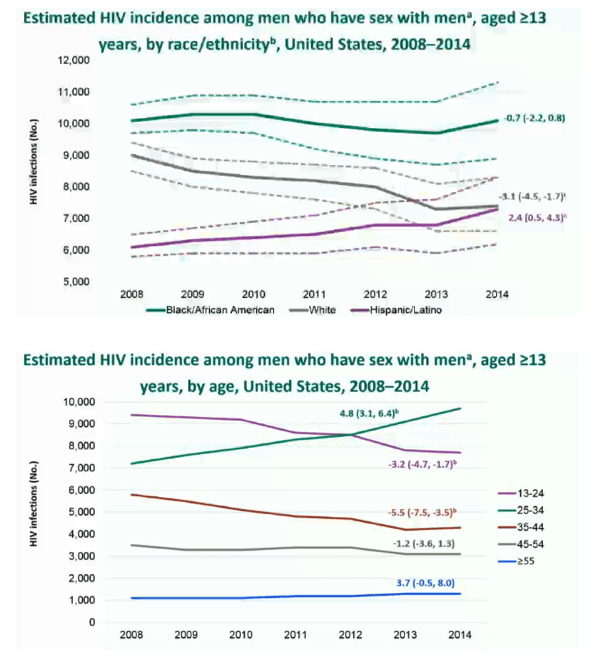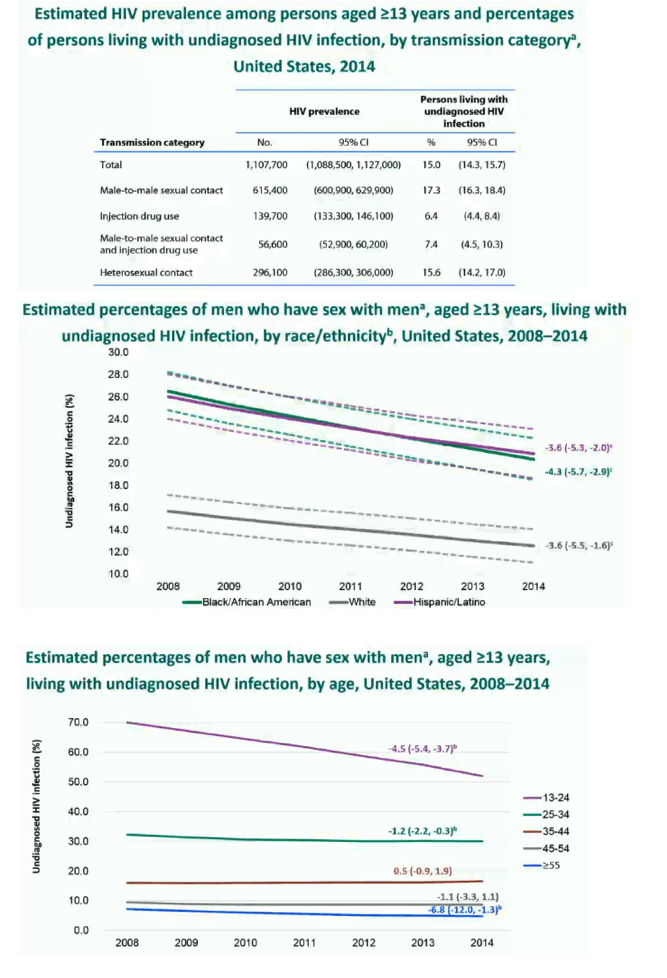 |
 |
 |
| |
US HIV Incidence Falling in All Transmission Risk Groups Except MSM
|
| |
| |
Conference on Retroviruses and Opportunistic Infections (CROI), February 13-16, 2017, Seattle

WEBCAST: http://www.croiwebcasts.org/console/player/33364?mediaType=slideVideo&
Mark Mascolini
HIV incidence (the new-infection rate) fell from 2008 through 2014 among all transmission risk groups in the United States except men who have sex with men (MSM), according to the latest numbers from the Centers for Disease Control and Prevention (CDC) [1]. Incidence remained high in black MSM, rose in Hispanic MSM, and fell in white MSM. Black and Hispanic MSM have similarly high rates of undiagnosed HIV infection.
CDC workers estimate that MSM make up about 2% of the US population but accounted for 67% of diagnosed HIV cases in 2015. To learn more about HIV incidence and prevalence--and undiagnosed HIV--in US MSM, the CDC team deployed new methods using national HIV surveillance data and CD4 tests.
Data for this analysis came from the CDC's National HIV Surveillance System. Researchers used the first CD4 result after HIV diagnosis, coupled with a well-characterized CD4-cell depletion model, to estimate the distribution of delay from HIV infection to diagnosis. Then they used the diagnosis delay distribution to estimate HIV incidence. To estimate HIV prevalence, the CDC combined HIV incidence results with cumulative numbers of HIV diagnoses and deaths. Finally they used estimated HIV prevalence and number of persons living with diagnosed HIV to estimate number and percentage of undiagnosed infections. All estimates involved people at least 13 years old.
From 2008 through 2014, the researchers estimated that overall US HIV incidence fell by 3.6% from more than 45,000 new cases yearly to under 40,000. The drop was sharpest for people who acquired HIV through drug injection (-13.8%), followed by heterosexually infected people (-7.3%) and MSM who inject drugs (-5.5%). But HIV incidence declined negligibly in MSM (-0.7%), who accounted for the greatest number of new infections by far (more than 25,000 yearly from 2008 through 2014). In comparison, heterosexual transmissions dropped from almost 15,000 in 2008 to under 10,000 in 2014.

Among MSM 13 years old or older, HIV incidence dipped negligibly among blacks from 2008 through 2014 (-0.7%), declined more in whites (-3.1%), and rose in Hispanics (+2.4%). By age among MSM, HIV incidence fell by 3.2% in 13-to-24-year-olds from 2008 through 2014, rose by 4.8% (to almost 10,000 yearly) among 25-to-34-year-olds, fell by 5.5% among 35-to-44-year-olds, fell by 1.2% among 45-to-54-year-olds, and rose by 3.7% among MSM 55 or older (about 1000 new infections yearly)

Estimated overall HIV prevalence in 2014 stood at 1,107,700, including 15% living with undiagnosed HIV. MSM accounted for an estimated 615,400 of those HIV cases (17.3% undiagnosed), followed by heterosexuals (296,100 cases, 15.6% undiagnosed), drug injectors (139,700 cases, 6.4% undiagnosed), and MSM drug injectors (56,600 cases, 7.4% undiagnosed). Thus, not even counting MSM drug injectors, MSM made up 55.5% of HIV cases in 2014 and had the highest percentage of undiagnosed cases.

HIV prevalence in 2014 stood at an estimated 243,000 cases among white MSM, at 198,100 among black MSM, and at 138,800 among Hispanic MSM. From 2008 through 2014, estimated percentage of undiagnosed HIV cases fell by 4.3% in black MSM, by 3.6% in Hispanic MSM, and by 3.6% in white MSM. By age, the percentage of MSM with undiagnosed fell by an estimated 4.5% from 2008 through 2014 in 13-to-24-year-olds, fell by 1.2% among 25-to-34-year-olds, stayed nearly flat (+0.5%) in 35-to-44-year-olds, fell by 1.1% in 45-to-54-year-olds, and fell by 6.8% in MSM 55 or older.
To conclude, the CDC underlined several disparities in HIV rates by race/ethnicity in MSM: (1) continued high HIV incidence among black MSM and increasing incidence in Hispanic MSM and in 25-to-34-year-olds, (2) higher percentages of undiagnosed HIV infection in black and Hispanic MSM, and (3) decreasing HIV incidence in young MSM, who nevertheless had a high (52%) rate of undiagnosed HIV in 2014. The researchers called for "tailored testing, prevention and treatment . . . for these groups to reduce HIV transmission."
Reference
1. Singh S, Song R, Johnson AS, McCray E, Hall I. HIV incidence, prevalence, and undiagnosed infections in men who have sex with men. Conference on Retroviruses and Opportunistic Infections (CROI), February 13-16, 2017, Seattle. Abstract 30.
|
| |
|
 |
 |
|
|